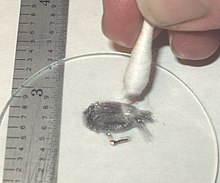鎵銦錫合金
鎵銦錫合金(Galinstan)是由鎵、銦和錫組成的共晶合金的品牌名,該合金在−19 °C(−2 °F)時熔化,因此在室溫下呈液態。[1]更廣泛地說,Galinstan也被用作各種類似合金的通用名稱,這些合金通常在+11 °C(52 °F)的溫度下熔化。 鎵銦錫合金由68.5% 的鎵、21.5% 的銦和10.0% 的錫組成(按重量計)。[2] 由於其成分金屬的低毒性和低反應性,在許多應用中,鎵銦錫合金已取代了有毒的汞或活躍的鈉鉀合金。
名稱
[編輯]名稱「Galinstan」是鎵(gallium)、銦(indium)和錫(拉丁語:stannum)的混成詞。
品牌名「Galinstan」是德國Geratherm Medical AG公司的註冊商標。
物理性質
[編輯]
- 沸點:> 1300 °C
- 熔點: -19 °C[3]
- 蒸氣壓:< 10−8 托(500 °C)
- 密度:6.44 g/cm3(20 °C)[4]
- 溶解度:不溶於水或有機溶劑
- 黏度: 0.0024 Pa·s(20 °C)
- 熱導率: 16.5 W·m−1·K−1
- 電導率:3.46×106S/m(20 °C)[4]
- 表面張力:s = 0.535–0.718 N/m (20 °C, 取決於成分)[5][6][7]
- 比熱容:296 J·kg−1·K−1[8]
鎵銦錫合金容易浸潤並粘附在包括玻璃在內的許多材料上。與汞相比,其使用受到了限制。
用途
[編輯]無毒的鎵銦錫合金代替了溫度計中的汞;管子內部必須塗有氧化鎵以防止其浸潤玻璃。 鎵銦錫合金比汞具有更高的反射率和更低的密度。在天文學中,它可以代替液體鏡面望遠鏡中的汞。[9] 超頻者和發燒友經常將在室溫下呈液態的金屬或合金(如鎵銦錫合金)用作計算機硬體冷卻的熱界面。與導熱膏相比,它們的導熱係數更高,而熱環氧樹脂可以允許稍高的時鐘速度和CPU處理能力實現演示和競爭超頻。有兩個例子,分別是Thermal Grizzly電導率儀和Coolaboratory Liquid Ultra,熱導率分別為73和38.4W/mK。[10][11]與易於使用且對硬體造成損壞的風險較低的普通導熱膠不同,鎵銦錫合金具有導電性,對多種金屬包括散熱器中的鋁具有腐蝕性。儘管存在這些挑戰,但成功完成其應用程式的用戶的確報告了良好的結果。[12]在2020年8月,索尼互動娛樂公司申請了一種適用於大規模生產的基於鎵銦錫合金的熱接口解決方案,[13]在PlayStation 5上獲得了專利。 鎵銦錫合金難以用於冷卻基於裂變的核反應爐,因為銦對於熱中子具有高吸收截面,可有效吸收它們並抑制裂變反應。相反,正在研究將其作為聚變反應爐的可能冷卻劑。它的非反應性使其比其他液態金屬(例如鋰和汞)更安全。[14]
X射線設備
[編輯]來自約10μm×10μm的焦點和3-D體素的9.25 keV X射線(鎵K-alpha線)的極高強度源,用於固定組織(例如小鼠腦)的X射線相顯微鏡檢查。使用液態鎵銦錫合金陽極的X射線源可獲得約1立方微米的雷射。[15] 金屬從噴嘴高速向下流動,高強度電子源將聚焦在其上。金屬的快速流動載有電流,但由於強制對流除熱,物理流動會阻止大量陽極加熱,而且鎵銦錫合金的高沸點會抑制陽極的蒸發。[16]
另見
[編輯]參考
[編輯]- ^ Surmann, P; Zeyat, H. Voltammetric analysis using a self-renewable non-mercury electrode.. Analytical and Bioanalytical Chemistry. Nov 2005, 383 (6): 1009–1013. PMID 16228199. doi:10.1007/s00216-005-0069-7.
- ^ Liu, Jing. Ch 5 Preparations and Characterizations of Functional Liquid Metal Materials. Liquid metal biomaterials : principles and applications. Yi, Liting. Singapore. 2018-07-14: 96 [2021-04-13]. ISBN 9789811056079. OCLC 1044746336. (原始內容存檔於2021-04-16).
- ^ ZHANG. Characterization of Triboelectric Nanogenerators. Flexible and stretchable triboelectric nanogenerator devices – toward self-powered ... systems.. WILEY. 2019: 70 [2021-04-13]. ISBN 978-3527345724. OCLC 1031449827. (原始內容存檔於2021-04-15).
- ^ 4.0 4.1 Experimental Investigations of Electromagnetic Instabilities of Free Surfaces in a Liquid Metal Drop (PDF). International Scientific Colloquium Modelling for Electromagnetic Processing, Hannover. March 24–26, 2003 [2009-08-08]. (原始內容 (PDF)存檔於2021-04-19).
- ^ Liu, Tingyi; Kim, Chang-Jin "CJ". Characterization of Nontoxic Liquid-Metal Alloy Galinstan for Applications in Microdevices. Journal of Microelectromechanical Systems. 2012, 21 (2): 448. CiteSeerX 10.1.1.703.4444
 . doi:10.1109/JMEMS.2011.2174421.
. doi:10.1109/JMEMS.2011.2174421.
- ^ Jeong, Seung Hee; Hagman, Anton; Hjort, Klas; Jobs, Magnus; Sundqvist, Johan; Wu, Zhigang. Liquid alloy printing of microfluidic stretchable electronics. Lab on a Chip. 2012, 12 (22): 4657–64. ISSN 1473-0197. PMID 23038427. doi:10.1039/c2lc40628d.
- ^ Handschuh-Wang, Stephan; Chen, Yuzhen; Zhu, Lifei; Zhou, Xuechang. Analysis and Transformations of Room-Temperature Liquid Metal Interfaces – A Closer Look through Interfacial Tension. ChemPhysChem. 2018-06-20, 19 (13): 1584–1592. ISSN 1439-4235. doi:10.1002/cphc.201800559
 .
.
- ^ Hodes, Marc; Zhang, Rui; Steigerwalt Lam, Lisa; Wilcoxon, Ross; Lower, Nate. On the Potential of Galinstan-Based Minichannel and Minigap Cooling. IEEE Transactions on Components, Packaging and Manufacturing Technology. 2014, 4 (1): 46–56. ISSN 2156-3950. doi:10.1109/tcpmt.2013.2274699 (美國英語).
- ^ Minerals Yearbook Metals and Minerals 2010 Volume I. Government Printing Office. 2010: 48.4 [2021-04-13]. (原始內容存檔於2021-04-15). Extract of page 48.4 (頁面存檔備份,存於網際網路檔案館)
- ^ Thermal Grizzly High Performance Cooling Solutions – Conductonaut. Thermal Grizzly. [2019-12-18]. (原始內容存檔於2021-04-15).
- ^ Wallossek 2013-10-21T06:00:01Z, Igor. Thermal Paste Comparison, Part Two: 39 Products Get Tested. Tom's Hardware. [2019-12-18] (英語).
- ^ Liquid Metal Laptop Cooling. [2021-03-05]. (原始內容存檔於2021-03-17) (英語).
- ^ WIPO Patentscope: "WO2020162417 - Electronic apparatus, semiconductor device, insulating sheet, and method for manufacturing semiconductor device. [2020-10-24]. (原始內容存檔於2021-04-13) (英語).
- ^ Lee C. Cadwallader. Gallium Safety in the Laboratory (preprint). 2003.
- ^ Hemberg, O.; Otendal, M.; Hertz, H. M. Liquid-metal-jet anode electron-impact x-ray source. Appl. Phys. Lett. 2003, 83: 1483. doi:10.1063/1.1602157.
- ^ Töpperwien, M.; et al. Three-dimensional mouse brain cytoarchitecture revealed by laboratory-based x-ray phase-contrast tomography. Sci. Rep. 2017, 7: 42847. doi:10.1038/srep42847
 .
.
資料來源
[編輯]- Scharmann, F.; Cherkashinin, G.; Breternitz, V.; Knedlik, Ch.; Hartung, G.; Weber, Th.; Schaefer, J. A. Viscosity effect on GaInSn studied by XPS. Surface and Interface Analysis. 2004, 36 (8): 981. doi:10.1002/sia.1817.
- Dickey, Michael D.; Chiechi, Ryan C.; Larsen, Ryan J.; Weiss, Emily A.; Weitz, David A.; Whitesides, George M. Eutectic Gallium-Indium (EGaIn): A Liquid Metal Alloy for the Formation of Stable Structures in Microchannels at Room Temperature. Advanced Functional Materials. 2008, 18 (7): 1097. doi:10.1002/adfm.200701216.
